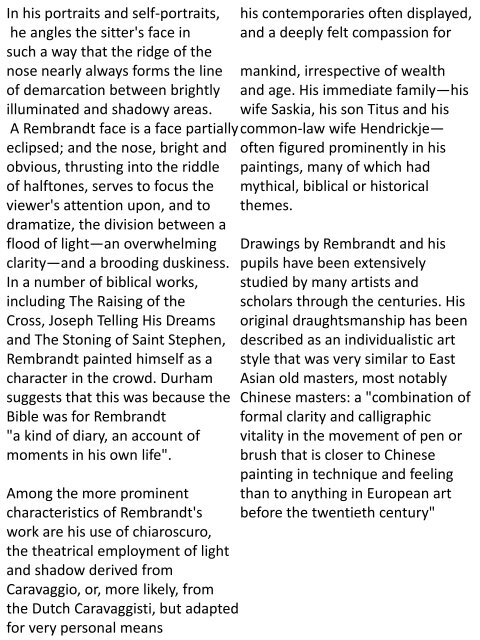Aziz Art January2018
History of art(west and middle east)- contemporary art
History of art(west and middle east)- contemporary art
Create successful ePaper yourself
Turn your PDF publications into a flip-book with our unique Google optimized e-Paper software.
In his portraits and self-portraits,<br />
he angles the sitter's face in<br />
such a way that the ridge of the<br />
nose nearly always forms the line<br />
of demarcation between brightly<br />
illuminated and shadowy areas.<br />
A Rembrandt face is a face partially<br />
eclipsed; and the nose, bright and<br />
obvious, thrusting into the riddle<br />
of halftones, serves to focus the<br />
viewer's attention upon, and to<br />
dramatize, the division between a<br />
flood of light—an overwhelming<br />
clarity—and a brooding duskiness.<br />
In a number of biblical works,<br />
including The Raising of the<br />
Cross, Joseph Telling His Dreams<br />
and The Stoning of Saint Stephen,<br />
Rembrandt painted himself as a<br />
character in the crowd. Durham<br />
suggests that this was because the<br />
Bible was for Rembrandt<br />
"a kind of diary, an account of<br />
moments in his own life".<br />
Among the more prominent<br />
characteristics of Rembrandt's<br />
work are his use of chiaroscuro,<br />
the theatrical employment of light<br />
and shadow derived from<br />
Caravaggio, or, more likely, from<br />
the Dutch Caravaggisti, but adapted<br />
for very personal means<br />
his contemporaries often displayed,<br />
and a deeply felt compassion for<br />
mankind, irrespective of wealth<br />
and age. His immediate family—his<br />
wife Saskia, his son Titus and his<br />
common-law wife Hendrickje—<br />
often figured prominently in his<br />
paintings, many of which had<br />
mythical, biblical or historical<br />
themes.<br />
Drawings by Rembrandt and his<br />
pupils have been extensively<br />
studied by many artists and<br />
scholars through the centuries. His<br />
original draughtsmanship has been<br />
described as an individualistic art<br />
style that was very similar to East<br />
Asian old masters, most notably<br />
Chinese masters: a "combination of<br />
formal clarity and calligraphic<br />
vitality in the movement of pen or<br />
brush that is closer to Chinese<br />
painting in technique and feeling<br />
than to anything in European art<br />
before the twentieth century"


















